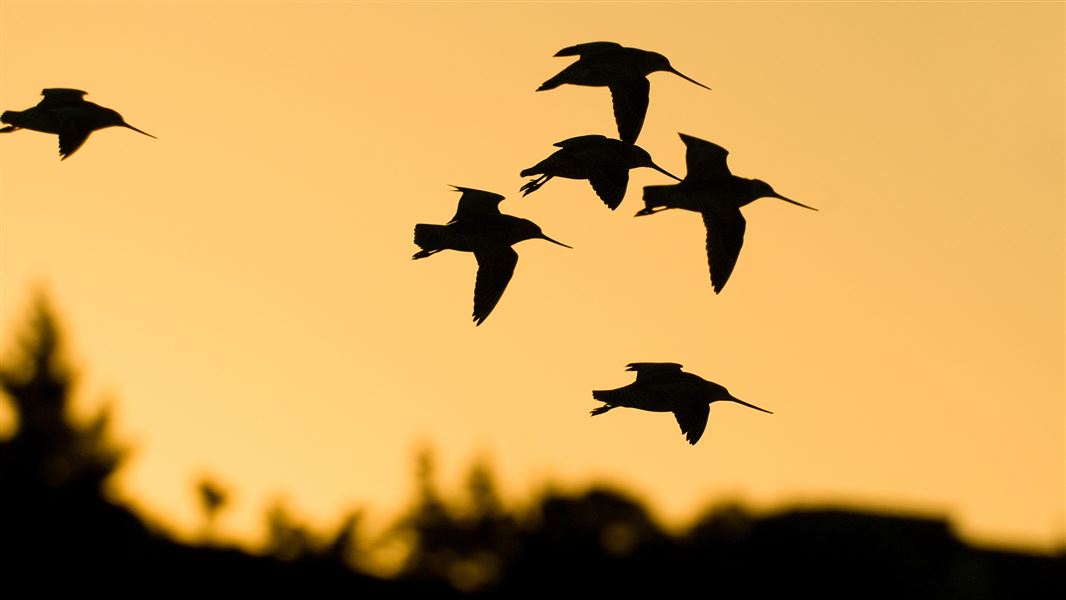Archived content: This media release was accurate on the date of publication.
Date: 20 September 2021
The adult male bird is known as 4BRWB because of the bands on his legs. He took off from tidal flats in Alaska’s Yukon-Kuskokwim delta on 11 September (NZ time) before encountering strong winds 2000 kms into his journey across the Pacific Ocean and turning back after flying for 33 straight hours.
4BRWB is one of 20 godwits fitted with radio transmitters in November 2019, says Massey University Associate Professor of Zoology Phil Battley - an ornithologist and godwit expert with a long association with the Pūkorokoro Miranda Shorebird Centre.
“He’s turned back 2000 kms into his flight – that seems like a lot to us, but it’s not that much to a godwit,” he says.
Other godwits who left the Yukon at the same time as 4BRWB have made it to New Zealand, with godwit-watchers reporting an influx of the birds over the last week. But it’s also feasible others also opted to u-turn.
4BRWB’s u-turn mid-migration is unusual: “Over the years we’ve tracked about 70 godwits leaving Alaska, and this is the first we know has had to turn back because of bad winds.”
Phil Battley says the real interest is now in what the bird does – how long it rests for, the route it takes, and “whether it will make it all the way down to New Zealand”.
“He’s still got time. He won’t have used all his energy – he’s just realised he was facing headwinds and thought ‘this isn’t a good start to a 10-day flight’… and turned back.”
4BRWB weighed 284 grams when he was banded. He will have weighed up to 500 grams when it took off from the Yukon and will burn up his fat reserves on its 11,000 km migration.
“This bird has a history with us already: he did a complete migration last year, and this is the second time we’re tracking it,” he says.
4BRWB’s mid-Pacific u-turn isn’t his first migratory misadventure.
“Last year, he also had difficult winds – strong easterlies – and he stopped in New Caledonia for a month, before eventually coming back here. If it’s been hit by a problem two years in a row, I think you can call it unlucky!
“But he’s a bird who knows how to survive by adjusting his behaviour when he has to. Another amazing thing about this bird is he left Yukon on exactly the same date this year as he did last year.”
The godwits’ massive migration flights mean some individual birds get lost or encounter difficulties, and some have “over-flown” their destination by several thousand kilometres.
“Last year we had one who crossed the entire North Pacific while trying to get to Alaska from Asia, having to backtrack 2500 km to reach its breeding grounds. Then, on the way south, it had to fly north-northwest to get around a low-pressure system and eventually ended up in Papua New Guinea.”
The godwits’ 11,000 km non-stop migration is one of the longest in the avian world. Last year, a male godwit – 4BBRW – created international headlines when it set what many believe to be a new distance record for the species for the Alaska-Firth of Thames flight, covering more than 12,000 km in 9.5 days
DOC Technical Advisor Bruce McKinlay says the research tools being used in this study are allowing those monitoring the species to assess the impact of weather on ultra-long-distance migration in real time, and also understand how adaptable to changing weather migrating godwits are. This is allowing for added depth in our understanding of how this species uses habitats across the Pacific.
Bruce McKinlay also says the research is contributing to building effective networks of protected areas in East Asia and supporting DOC’s conservation work in China and South Korea. The real time reporting of birds stopping over in South Korea in the Northern Hemisphere spring this year was used to enhance boundaries of World Heritage site nominations.
People can follow the godwits’ progress online via the Pūkorokoro Miranda Shorebird Centre Twitter account, or via the Global Flyway Network website.
Godwits are classed as declining due to loss of their habitat.
Contact
For media enquiries contact:
Email: media@doc.govt.nz
